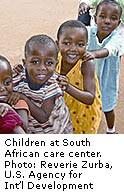
WEDNESDAY, June 16 (HealthDay News) — In sub-Saharan Africa, many mothers with HIV are faced with an awful choice: breast-feed their babies and risk infecting them or use formula, which is often out of reach because of cost or can sicken the baby due to a lack of clean drinking water.
Now, two new studies find that giving pregnant and nursing women triple antiretroviral drug therapy, or treating breast-fed infants with an antiretroviral medication, can dramatically cut transmission rates, enabling moms to both breast-feed and to protect nearly all children from infection.
In one study, a combination antiretroviral drug therapy given to pregnant and breast-feeding women in Botswana kept all but 1 percent of babies from contracting the infection during six months of breast-feeding.
Without the drug therapy, about 25 percent of babies would become infected with the AIDS-causing virus, according to researchers from the Harvard School of Public Health.
A second study, led by researchers from the University of North Carolina at Chapel Hill, found that giving babies an antiretroviral drug once a day during their first six months of life reduced the transmission rate to 1.7 percent.
Both studies are published in the June 17 issue of the New England Journal of Medicine.
In the United States, HIV-positive women are typically given antiretrovirals during pregnancy to avoid passing HIV to their babies in utero or during labor and delivery. After the baby is born, women are advised to use formula instead of breast-feeding for the same reason, said senior study author Dr. Charles M. van der Horst, a professor of medicine and infectious diseases at the University of North Carolina at Chapel Hill.
That works well in developed nations where formula is easy to come by and a clean water supply is readily available, van der Horst said.
But throughout much of sub-Saharan Africa, water supplies can be contaminated by bacteria and other pathogens that, especially in the absence of good medical care, can cause diarrheal illnesses that can be deadly for babies.
Previous research has shown that formula-fed babies in the region die at a high rate from pneumonia or diarrheal disease, leaving women in a Catch-22.
“In Africa, breast milk is absolutely essential for the first six months of life,” van der Horst said. “Mothers there know that. It was a ‘between a rock and a hard place’ issue for them.”
In the Botswana study, Harvard researchers gave 730 HIV-infected pregnant women one of three combinations of antiretroviral drugs starting between 26 weeks and 34 weeks gestation and continuing through six months after the baby’s birth, at which point they would wean the child. Infants also received a single dose of nevirapine and four weeks of another antiretroviral medication.
Among those babies, the rate of mother-to-child transmission was 1.1 percent, the lowest ever reported, according to the study. The three versions of drug combinations had similar efficacy.
In the study conducted in Malawi, HIV-positive mothers were given either antiretrovirals after delivery and while breast-feeding, or instructed to give their babies a single vial of the drug nevirapine daily. Infants in a third control group received a single dose of nevirapine and seven days of two other antiretroviral drugs.
About 5.7 percent of babies in the control group and 2.9 percent of babies whose mothers took the triple-drug therapy became infected with HIV by 6 months. The 2.9 percent figure could probably be lowered by starting the drug cocktail during pregnancy, van der Horst said.
Yet van der Horst believes for the poorest of the poor in Africa, the infant regimen is more feasible than triple-drug therapy for moms, which requires testing and monitoring and medical facilities to do so.
For infants, nevirapine is widely available and inexpensive relative to other drugs, and the once-a-day dosage is easy to carry out, he said.
“We found the infant nevirapine was incredibly safe, incredibly cheap, well-tolerated and it works incredibly well, almost completely shutting off transmissions immediately,” van der Horst said.
Dr. Rodney Wright, director of HIV programs in the department of obstetrics and gynecology at Montefiore Medical Center in New York City, called the findings “very encouraging.” The studies show rates of mother-to-child transmission comparable to those in the developed world.
“The studies show women in the developing world can have low levels of transmission of HIV from mother to child, even in the setting of breast-feeding,” Wright said. “One of the big issues has always been the dilemma to choose between healthy breast-feeding, which carries with it the risk of HIV transmission, and issues of poor water supplies.”
Researchers don’t know why a small number of babies continue to get infected with HIV, but it could be due to a variety of reasons, including missed dosages or other infections that could prevent the medications from being absorbed properly.
About 430,000 children are infected with HIV worldwide each year, about 40 percent of whom are infected through breast-feeding, according to an accompanying editorial.
More information
The U.S. Centers for Disease Control and Prevention has more on HIV.

